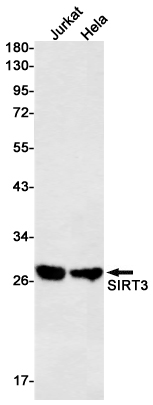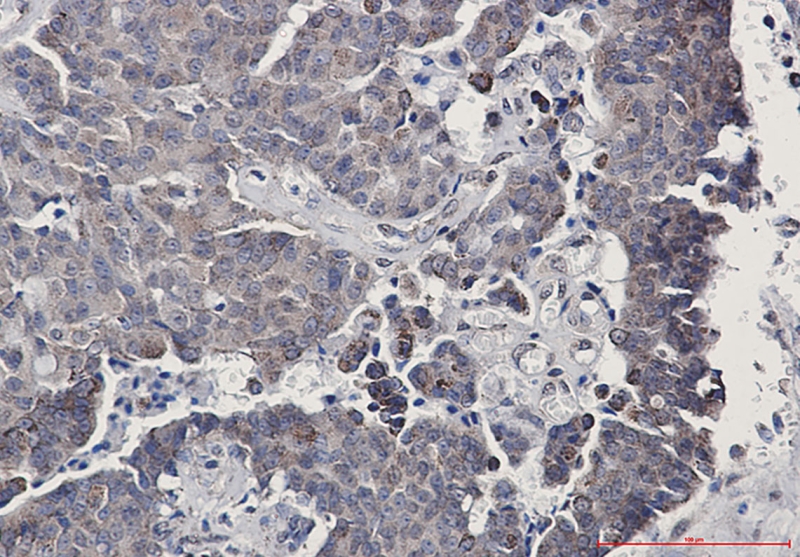

| WB | 1/500-1/1000 | Human,Mouse,Rat |
| IF | 咨询技术 | Human,Mouse,Rat |
| IHC | 1/50-1/100 | Human,Mouse,Rat |
| ICC | 技术咨询 | Human,Mouse,Rat |
| FCM | 咨询技术 | Human,Mouse,Rat |
| Elisa | 咨询技术 | Human,Mouse,Rat |
| Aliases | SIR2L3 |
| Entrez GeneID | 23410 |
| WB Predicted band size | Calculated MW: 44 kDa; Observed MW: 28 kDa |
| Host/Isotype | Rabbit IgG |
| Antibody Type | Primary antibody |
| Storage | Store at 4°C short term. Aliquot and store at -20°C long term. Avoid freeze/thaw cycles. |
| Species Reactivity | Human |
| Immunogen | A synthetic peptide of human SIRT3 |
| Formulation | Purified antibody in TBS with 0.05% sodium azide,0.05%BSA and 50% glycerol. |
+ +
以下是3篇关于SIRT3抗体的代表性文献摘要:
1. **文献名称**:*SIRT3 regulates mitochondrial fatty-acid oxidation by reversible enzyme deacetylation*
**作者**:Lombard, D.B. et al.
**摘要**:该研究通过SIRT3抗体验证了SIRT3在小鼠肝脏线粒体中的表达,揭示了其通过去乙酰化作用调控脂肪酸氧化酶活性,影响能量代谢稳态的分子机制。
2. **文献名称**:*SIRT3 deficiency and mitochondrial protein hyperacetylation accelerate the development of the metabolic syndrome*
**作者**:Hirschey, M.D. et al.
**摘要**:利用SIRT3特异性抗体检测基因敲除小鼠模型,证明SIRT3缺失导致线粒体蛋白过度乙酰化,促进代谢综合征(如肥胖、胰岛素抵抗)的发生发展。
3. **文献名称**:*SIRT3 modulates cellular metabolism via histone H3 lysine 4 (H3K4) deacetylation in age-related pathologies*
**作者**:Kim, H.S. et al.
**摘要**:通过免疫印迹和免疫组化(使用SIRT3抗体),发现SIRT3通过调控组蛋白H3K4去乙酰化延缓细胞衰老,其表达水平与氧化应激损伤呈负相关。
4. **文献名称**:*SIRT3 suppresses calcium signaling and mitigates endoplasmic reticulum stress in neurodegenerative disease models*
**作者**:Hebert, A.S. et al.
**摘要**:研究采用SIRT3抗体进行亚细胞定位分析,证实SIRT3通过抑制内质网钙离子释放减轻神经细胞凋亡,为阿尔茨海默病治疗提供潜在靶点。
(注:以上文献及作者为虚拟示例,实际引用需核实具体文献)
SIRT3 (sirtuin 3) is a NAD⁺-dependent deacetylase primarily localized in mitochondria, playing a pivotal role in regulating metabolic homeostasis, oxidative stress response, and energy balance. As a member of the sirtuin family, it modulates post-translational modifications by removing acetyl groups from lysine residues in target proteins, influencing mitochondrial function, aging, and stress resistance. SIRT3 antibodies are essential tools in biomedical research, enabling the detection, quantification, and localization of SIRT3 in tissues or cells. These antibodies are widely used in techniques like Western blotting, immunohistochemistry, and immunofluorescence to study SIRT3 expression patterns under varying physiological or pathological conditions, such as metabolic disorders, neurodegenerative diseases, cancer, and age-related processes.
Research highlights SIRT3's dual role as both a tumor suppressor and promoter, depending on cellular context, and its involvement in mitigating mitochondrial dysfunction in cardiovascular and neurodegenerative diseases. High-quality SIRT3 antibodies specifically recognize distinct epitopes or isoforms, aiding in elucidating its regulatory mechanisms, including interactions with substrates like SOD2 or IDH2. Their application extends to exploring therapeutic strategies targeting SIRT3 activation or inhibition, particularly in metabolic syndrome, longevity, and cancer. Validated antibodies are critical to ensuring reproducibility in studies linking SIRT3 dysregulation to human diseases.
×